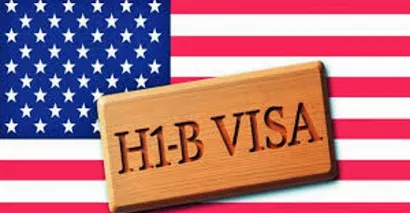Key Highlights
- US Policy Changes Create Unprecedented Hurdles
- Economic Impact on India's Growth Trajectory
- Industry Response and Adaptation Strategies
- Global Competition for Indian Talent
- Humanitarian and Family Concerns
- Long-term Implications for US-India Relations
- Alternative Pathways and Future Outlook
- Conclusion
The Reserve Bank of India Monetary Policy Committee member has sounded serious warning flags regarding future challenges for Indian professionals to obtain H-1B visas. With the Trump administration bringing in more stringent visa rules and a large fee hike, India's IT industry has unprecedented challenges ahead. This is even as bilateral tension between the US and India keeps influencing trade relations and the mobility of skilled workers.
US Policy Changes Create Unprecedented Hurdles
The Trump administration's move to charge a whopping $100,000 a year for new H-1B visa applications is a seismic change in US immigration policy. The move, slated to take effect from September 2025, aims at the very program that has helped thousands of Indian professionals contribute to American innovation and economic growth.
Indians today account for about 71% of all H-1B visa approvals and thus remain the most impacted group. The new fee system, in conjunction with tighter application standards, acts as a significant hurdle for Indian IT specialists who have long depended on this avenue for working in the United States.
Also Read: Biden Administration Withdraws Trump-Era Immigration Rules
Economic Impact on India's Growth Trajectory
Dr Nagesh Kumar's analysis identifies that although the overall GDP impact might be limited to 40-60 basis points, some sectors are disproportionately impacted. The RBI analysis indicates specific weakness in:
-
IT Services Sector: Large players such as TCS, Infosys, and Wipro rely heavily on H-1B visas to conduct their US operations
-
Labour-Intensive Exports: Textiles, garments, leather, gems and jewellery sectors could come under further pressure
-
Remittance Flows: Decreased Indian professional numbers in the US could influence foreign exchange inflows
|
Sector |
US Export Share |
Potential Impact |
|
IT Services |
60% |
High - Direct H-1B dependency |
|
Textiles & Garments |
33% |
Medium - Labor market effects |
|
Pharmaceuticals |
15% |
High - Patent tax implications |
Industry Response and Adaptation Strategies
Leading Indian IT companies have begun implementing strategic changes to mitigate H-1B visa challenges:
- Tata Consultancy Services (TCS) has proactively scaled up local hiring in the United States, reducing dependence on H-1B visas. This strategic shift aims to minimise potential disruptions from the new visa policies.
- Infosys and Wipro are exploring similar approaches, though the transition involves significant cost implications. A company requiring 3,000 H-1B visas would face $300 million in fees under the new structure.
- HCL Technologies continues balancing high-cost local US recruitment with offshore talent utilization, though the economics have become increasingly challenging.
|
Company |
Estimated Annual H-1B Applications |
New Fee Impact |
|
TCS |
5,000 |
$500 million |
|
Infosys |
3,000 |
$300 million |
|
Wipro |
2,000 |
$200 million |
Also Read: US Extends Green Card Validity for Renewal Applicants: Key Updates
Global Competition for Indian Talent
International Competition for Indian Expertise
- The H-1B visa limits have inadvertently opened up spaces for other nations actively seeking Indian professionals:
- Canada has emerged as a desirable destination with expedited visa procedures and routes for permanent residency. Canada's Express Entry framework and Provincial Nominee Programs have targeted skilled Indian professionals.
- United Kingdom has launched the Global Talent Visa and Skilled Worker routes, facilitating easier migration of Indian professionals post-Brexit.
- Australia and Germany are promoting themselves as hotbeds of innovation with streamlined visa regulations and enticing career opportunities for technology experts.
Humanitarian and Family Concerns
The Ministry of External Affairs has expressed humanitarian concerns regarding the policy adjustments, citing family disruptions. Indian professionals have faced tough decisions between professional responsibilities and family commitments, with some postponing family visits or hurrying to make flight reservations before new restrictions are imposed.
The policy uncertainty has caused concern among current H-1B visa holders who are afraid of renewal opportunities and long-term professional security in the US.
Long-term Implications for US-India Relations
These visa policy reforms take place amidst deeper US-India trade tensions. The Trump administration has introduced different measures which may impact bilateral economic cooperation:
-
HIRE Act provisions in favour of local workers
-
100% tax on patented Indian medicines
-
Higher tariffs on other Indian exports
Also Read: US Issues Over 1 Million Non-Immigrant Visas to Indians
Alternative Pathways and Future Outlook
Although there is a challenge in place at present, there are still various alternative routes available for Indian professionals:
- EB-1 and EB-2 visas still offer avenues for high talent and holders of advanced degrees, albeit processing times are still long.
- L-1 intra-company transfer visas still offer possibilities for professionals employed by multinational companies with US operations.
- O-1 visas for those of extraordinary ability are still not impacted by existing policy developments.
- Industry observers hold the view that the existing limitations are transitory and may be subject to policy changes based on economic requirements and political considerations.
Conclusion
H-1B visa troubles ahead for India represent a significant challenge that requires strategic adaptation from both government and industry stakeholders. While the RBI's warning highlights serious concerns about economic impact, Indian companies and professionals are already implementing innovative solutions to navigate this complex landscape. The long-term success of these adaptations will depend on continued dialogue between US and Indian authorities, as well as the development of alternative pathways for skilled worker mobility. For official updates on H-1B visa policy impacts and India's response, visit the Ministry of External Affairs' official statement, which addresses the humanitarian and economic concerns regarding recent US immigration restrictions. To know more about the US H-1B visa, TerraTern now!








